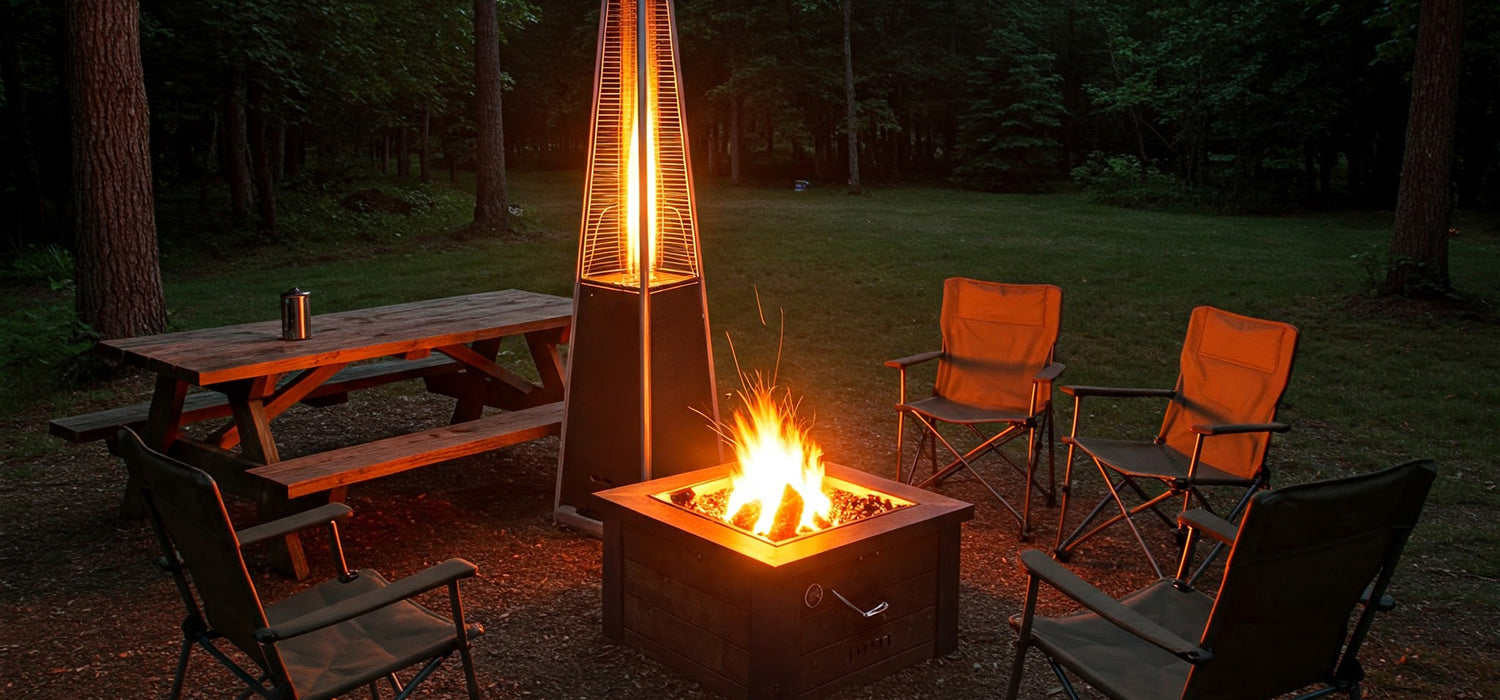
The Ultimate Guide to Choosing a Gas Fire Pit for Camping
Ready to ditch the smoky mess and endless wood gathering? A gas fire pit or fire table for camping is your ticket to cosy, hassle-free campfires! Whether you're relaxing by a crackling flame or using sleek fire tables, this guide will show you why propane fire pits are a camping must-have. Keep reading!
Choosing a Portable Gas Fire Pit for Camping
Size and Weight:
Compact and Lightweight Designs
When it comes to portable gas fire pits, size and weight matter. You don't want to lug around a bulky, cumbersome setup when you're heading out on your camping trip. Fortunately, modern designs are sleek and lightweight, offering a hassle-free camping experience. A compact fire pit is easy to stow away, whether you’re driving, hiking, or RV camping.
Easy Storage and Transport
You’ll appreciate a gas fire pit that’s quick to pack away, especially when you're juggling all your camping gear. Many models come with handles or bags to make transportation even easier. And if you’re space-conscious, look for a design that doesn’t take up valuable room in your car, RV, or tent. A portable fire pit should be all about convenience—keeping you warm without the bulk!
Fuel Efficiency:
Low Gas Consumption
A good gas fire pit won’t leave you scrambling for a refill halfway through the evening. Look for models that use fuel efficiently, giving you plenty of burn time without burning through propane too quickly. This means fewer trips to the propane store and more time spent enjoying the warmth of the fire.
Long Burn Time
The beauty of a gas fire pit is its long, continuous burn time. Unlike traditional wood fires, which often require constant tending, a propane fire pit provides hours of reliable warmth and ambiance. A tank can last longer than you might think, depending on the size of the pit and the flame height you choose. So, whether you’re chatting under the stars or roasting marshmallows, you won’t need to worry about running out of fuel.
Safety Considerations for Camping
Clearance and Distance:
Maintaining a Safe Distance from Tents and Surrounding Areas
When you set up your gas fire pit, make sure to place it far from anything that could catch fire. This includes tents, sleeping bags, dry grass, or any other flammable materials nearby. Think of your campfire as the centrepiece of your campsite, but it should always be at a safe distance to prevent accidents.
Protecting from Wind and Weather
Wind can quickly turn a cosy flame into a hazard. Position your fire pit in a spot that’s shielded from gusts, and always consider the weather conditions before lighting the fire. Windy days can send sparks flying, so always keep safety in mind. Some fire pits come with wind screens to keep the flames under control, making them perfect for less-than-ideal weather.
Surface Protection:
Protecting Surfaces from Heat Damage
While a gas fire pit is safer than a wood-burning campfire, you still need to consider where you’re setting it up. High heat can damage sensitive surfaces like grass or picnic tables. Always choose a flat, heat-resistant surface to place your fire pit, and avoid using it directly on the ground or wooden decks.
Using Heat-Resistant Mats or Surfaces
To avoid any damage to the ground or surfaces, use heat-resistant mats under your gas fire pit. These mats act as a protective layer, keeping surfaces safe from high temperatures. They're an easy, inexpensive solution to ensure your campsite remains unscathed, even after hours of toasting marshmallows.
Fuel Options and Usage
Propane Tanks:
Portable Propane Tanks for Camping
Propane is the go-to fuel for most portable camping fire pits, and for good reason. Propane tanks are easy to find and simple to use. Whether you’re camping in a remote location or just need a quick refill, portable propane tanks are an ideal choice. Look for a model that allows you to easily connect and disconnect the tank, ensuring that your fire pit is ready to go whenever you are.
Proper Ventilation for Tank Storage
It’s crucial to store your propane tank in a well-ventilated area. Never leave a tank in a hot or closed space like your car or tent, as this could lead to a dangerous buildup of pressure. Keep your tank in a shaded spot, preferably upright, to avoid leaks and ensure it remains safe to use.
Flame Adjustment and Control:
Adjusting Flame Height for Desired Ambiance
One of the best features of a gas fire pit is the ability to adjust the flame. Whether you want a big, blazing fire to warm up after a hike or a softer glow to enjoy a quiet evening, the flame control lets you set the mood. Most portable fire pits come with a simple dial to adjust the intensity of the flames, giving you full control over your campfire experience.
Maintenance and Cleaning
Cleaning Burner and Surface:
Removing Debris and Spills
Keep your fire pit in top shape by regularly cleaning the burner and surface. After each use, wipe down the surface with a damp cloth and remove any debris or food spills. This helps prevent any build-up that could affect performance and makes your fire pit last longer. A little care goes a long way, and cleaning after each use is an easy way to maintain your camping gear.
Checking for Gas Leaks:
Using a Soap Solution
It’s important to check for gas leaks every so often, just to be on the safe side. A simple way to do this is by applying a soapy water solution to the gas line and connections. If you see bubbles forming, it’s a sign that there’s a leak. You’ll need to fix it before using the fire pit again. This quick check can save you from unnecessary worry and keep your fire pit running smoothly.
Conclusion
A gas fire pit for camping is the perfect way to upgrade your outdoor experience. It offers all the warmth and cosy vibes of a traditional fire without the mess, smoke, or endless wood-gathering. By choosing a compact, fuel-efficient model, setting it up safely, and keeping up with maintenance, you'll have a campfire that’s hassle-free and perfect for any camping adventure. So, next time you're heading out to the wild, don't forget to pack your portable propane fire pit—your campsite will never be the same again!
Other content we think you'll love
- Gas Fire Pit for S’mores: Your Guide to Gooey Backyard Treats
- Can You Use a Fire Pit When It’s Windy? (Yes—Here’s How to Stay Safe and Cosy)
- The Ultimate Guide to Choosing a Tabletop Gas Fire Pit
- Gas Fire Pit for Small Patios: The Perfect Solution for Cosy Outdoor Vibes
- Gas Fire Pit for Covered Porch: Enjoy Cozy Warmth All Year Round
- Gas Fire Pit for RV: Your Cosy Companion on the Road
- The Best Portable Gas Fire Pit for Motorhome Camping: A Complete Guide
- Choosing the Perfect Gas Fire Pit for Your Garden
- Are Fire Pit Dining Tables Worth It?
- The Ultimate Guide to Cooking on a Gas Fire Pit
- Are Fire Tables Worth It? Here's What You Need to Know Before Buying
- Are Fire Tables Warm Enough? A Complete Guide to Heat Output
- The Ultimate Guide to Popcorn Making with a Fire Table
- Can You Roast Marshmallows Over a Gas Fire Pit?
- Are Gas Fire Pit Tables Any Good? A Full Guide to Cosy Outdoor Living
- When to Use a Fire Pit: Timing is Everything!

